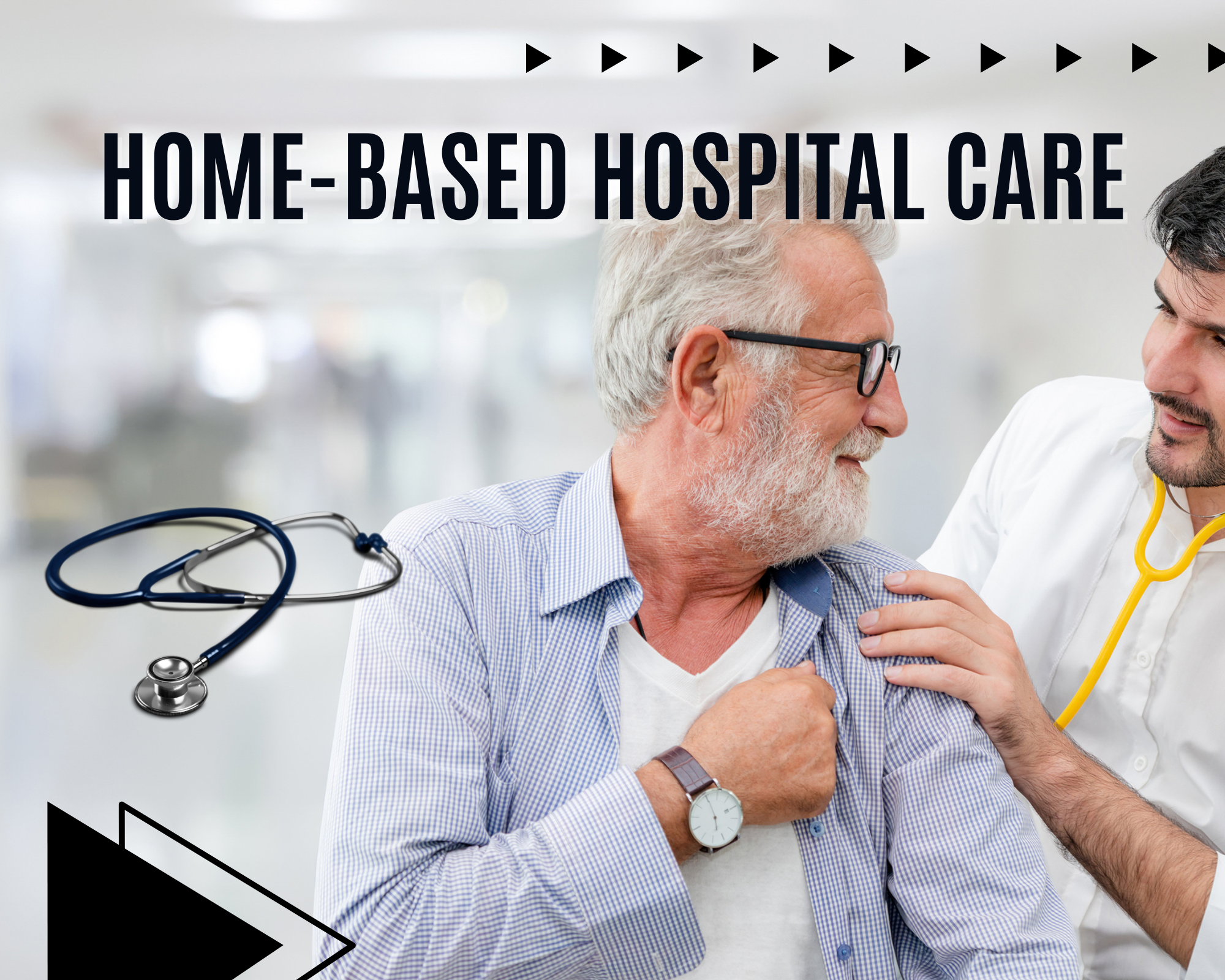Imagine recovering from surgery at home, with your loved ones nearby. Remote monitoring and wearables are making this possible. They are changing how we handle post-operative recovery.
Thanks to new technology, Home-Based Hospital Care is growing in popularity. It lets patients get the care they need at home. This approach is not only better for patients but also saves money and eases hospital workloads.
Key Takeaways
- Remote monitoring is revolutionizing post-op recovery by allowing patients to receive care from home.
- Wearables are playing a crucial role in tracking patient health and improving outcomes.
- Home-Based Hospital Care is reducing healthcare costs and alleviating the burden on hospitals.
- Personalized care is becoming more accessible, enhancing the patient experience.
- Technology is expected to continue evolving, leading to even more innovative post-operative care solutions.

As technology keeps getting better, we’ll see even more new ways to care for patients after surgery. You can look forward to a recovery that’s more personal and comfortable. You’ll be able to keep an eye on your health and get care from home.
The Current State of Post-Operative Care
Healthcare is changing, and so is how we care for patients after surgery. How patients recover affects their health and how happy they are with their care.
Traditional Hospital Recovery Models
For a long time, hospitals have been the main place for post-operative care. Hospital recovery models offer intense care right after surgery. A team of doctors, nurses, and rehab experts work together to help patients.

Challenges and Limitations of In-Hospital Recovery
Even with the good things about hospital care, there are downsides. There’s a risk of hospital-acquired infections, high costs, and patients might not like the hospital. Also, staying in the hospital too long can make things worse.
- Limited availability of hospital beds and resources
- Increased risk of hospital-acquired infections
- High healthcare costs associated with prolonged hospital stays
- Enhanced recovery after surgery (ERAS) programs were introduced into the surgical practice over two decades ago as evidence-based, multi-disciplinary interventions in all the perioperative phases of a patient’s surgical journey that work synergistically to minimise the surgical stress response, reduce complications, and enhance outcomes.
The Need for Alternative Recovery Solutions
Because of these issues, people are looking for new ways to care for patients after surgery. Options like home-based hospital care and telehealth services are becoming more popular. They offer more comfort and flexibility, and can save money and improve health outcomes.
“The future of post-operative care lies in finding a balance between technological advancements and personalized patient care.”
This change towards new recovery methods is about making care better, cheaper, and more effective. As healthcare keeps changing, we’ll likely see more creative ways to help patients recover.
What Is Home-Based Hospital Care?
Home-Based Hospital Care is changing how we recover after surgery. It lets you heal at home, using the latest tech and care that’s just for you.
Defining the Home-Based Hospital Model
The Home-Based Hospital Model offers care outside of hospitals. It uses remote monitoring systems and wearable technology to keep an eye on your health. This way, doctors can spot and fix problems fast.
It also includes telehealth platforms for easy talks with your healthcare team. This means you get help whenever you need it during your recovery.The median length of stay and the rate of readmissions were lower in people under HaH care. Compared with patients in a hospital setting, patients in HaH had better clinical outcomes. HaH unit provides an integrated, flexible, easy-to-scale platform that can be cost-effectively adapted to high-demand situations.
Key Components of Effective Home Recovery Programs
Good home recovery programs have a few key parts:
- Personal care plans made just for you
- Advanced tech to watch your recovery
- 24/7 help from healthcare pros
- Teaching your family to help with care

Patient Selection Criteria for Home Recovery
Not everyone can use Home-Based Hospital Care. To qualify, you need:
- To be stable after surgery
- To be able to take care of yourself, maybe with help
- To have the right tech for monitoring
Choosing the right patients and giving them the right care makes Home-Based Hospital Care a great option for recovery.
Wearable Technology Revolutionizing Patient Monitoring
Wearable technology has changed post-operative care. It lets patients monitor their health at home. This makes recovery after surgery better for many.
Wearable technology developed into a transformative healthcare force which changed how patients connect with providers and handle their health while obtaining medical care in the evolving healthcare landscape. The continuous glucose monitoring technology together with smart watch detection of arrhythmias has fundamentally changed how patient-centered healthcare operates.
Wearables started as technological novelties before becoming crucial tools to monitor patients remotely and track chronic diseases and prevent health problems and aid medical staff in their clinical decisions. Wearable technology integration with healthcare systems allows worldwide value-based care transition to bring better patient outcomes and life quality alongside reduced expenses.
Vital Sign Monitoring Devices
Vital sign monitoring devices are key for tracking health in real-time. They help doctors keep an eye on important health signs. This way, they can act fast if needed.
Heart Rate and ECG Monitors
Heart rate and ECG monitors are vital for heart health. They track heart activity. This helps catch problems early. Early detection can prevent serious issues.
Blood Pressure and Oxygen Saturation Devices
Blood pressure and oxygen saturation devices check heart and lung health. They are crucial for knowing how well a patient is doing. They help spot any health changes.
Movement and Activity Tracking Solutions
Movement and activity tracking solutions are important for recovery. They help patients stay active. Staying active is key for quick recovery.
“Wearable devices have transformed the way we monitor patients. They provide real-time data that can be lifesaving.” – Dr. Jane Smith, Cardiologist
Smart Medication Dispensers and Adherence Technology
Smart medication dispensers and adherence technology help with taking medicine. They remind patients to take their meds on time. This lowers the chance of forgetting.
Medication Reminder Systems
Medication reminder systems are part of smart dispensers. They make sure patients take their meds as they should. This is especially helpful for those with many medicines.
Wearable technology helps healthcare give better care. It makes care more personal and responsive. As it gets better, it will play a bigger role in recovery after surgery.
Remote Monitoring Systems and Digital Infrastructure
Remote monitoring systems are key to home-based hospital care. They let patients get care at home. These systems need strong digital infrastructure to work well for post-operative patients.In recent years, the proliferation of affordable smart devices, including smartphones, smartwatches, and Bluetooth-enabled sensors, has paved the way for the emergence of mobile health applications. These devices incorporate various sensors such as accelerometers, gyroscopes, proximity beacons, and ECG sensors, some of which are integrated into smartwatches or smartphones.
Telehealth Platforms Supporting Post-Op Care
Telehealth platforms are vital for talking between patients and doctors. They offer secure video consultations. This means you can get care without going to the hospital.
Using telehealth helps avoid infections from hospitals. It’s a big plus for your health.
Data Collection, Analysis, and AI Integration
Data analysis is a big part of remote monitoring. Artificial Intelligence (AI) helps look at lots of patient data. It finds trends and warns of possible problems.
This lets doctors act fast to help patients. It makes care better and safer.
Alert Systems and Emergency Response Protocols
Alert systems are important for quick help. They send messages to doctors when a patient’s condition changes. This ensures doctors can act fast.
Having clear emergency plans means you can relax. You know help is always ready.
Mobile Applications for Patient-Provider Communication
Mobile apps make talking to doctors easy. You can share health updates, ask questions, and get care tips. These apps make care more personal and quick.
| Feature | Benefit | Impact |
|---|---|---|
| Telehealth Platforms | Enhanced patient-provider communication | Improved patient satisfaction |
| AI Integration | Predictive analytics for complication prevention | Reduced readmission rates |
| Alert Systems | Prompt response to patient needs | Enhanced patient safety |
Benefits of Home-Based Hospital Care for Patients
Home-Based Hospital Care lets you recover in a way that feels personal and comfortable. It offers many benefits that make your recovery better.
Enhanced Comfort and Psychological Well-being
Recovering at home means you’re in a place you know and love. This can really boost your mental health. A calm and stress-free atmosphere helps you rest better, feel less anxious, and stay positive about getting better. Research shows that people recovering at home feel less stressed and anxious than those in hospitals.
Reduced Hospital-Acquired Infection Risk
Staying out of the hospital means you’re less likely to catch infections. Home-Based Hospital Care keeps you safe while still giving you the care you need. This is especially good for people with weak immune systems.
Financial Advantages for Patients
Home-Based Hospital Care can save you money. It cuts down on costs like food, transportation, and accommodation for family members. Plus, recovering at home can make your recovery faster, which can also save money in the long run.
Family Support and Involvement in Recovery
Being at home lets your family help more with your recovery. They can offer emotional support, help with daily tasks, and manage your medicine.
“Having my family around me during recovery made a huge difference. It felt like I was in good hands, and that really helped me heal faster.”
This support is key to your recovery. It can lead to better results and make you happier with your care.
Healthcare System Advantages
Remote monitoring and wearables are changing healthcare. They make home care better and cheaper. This new way helps hospitals work better, saves money, and improves care quality.
Hospital Capacity and Resource Optimization
Home care means hospitals use resources better. They don’t need as many beds. This makes hospitals more efficient and cuts down wait times for urgent care.Strengthening primary health care and the attainment of universal health coverage are both important current global health policy initiatives. Primary health care is essential and affordable care that is accessible to everyone in the community, and includes health promotion, disease prevention, health maintenance, education and rehabilitation.
Cost-Effectiveness for Healthcare Providers
Home care is cheaper for hospitals. It shortens stays and cuts down on readmissions. This saves money without sacrificing quality, which is key today.
Insurance Coverage and Reimbursement Models
More insurers are covering home care. As it proves effective, they’re more likely to pay for it. Soon, there will be more options for coverage.
Quality Metrics and Outcome Improvements
Home care is not just cheaper; it also improves patient results. It lets doctors monitor and act quickly. This leads to fewer problems and faster healing. So, hospitals can show they’re doing a better job.
In short, home-based hospital care offers many benefits. It improves how hospitals work, saves money, and makes patients healthier. As healthcare changes, using this model can help providers offer better care and make patients happier.
Real-World Implementation and Success Stories
The move to Home-Based Hospital Care is growing fast, with many success stories. Healthcare providers are embracing this new way, seeing big benefits for everyone. Patients, providers, and the healthcare system are all winning.
Cardiac Surgery Home Recovery Programs
A top hospital started a Home-Based Hospital Care program for heart surgery patients. This led to a 30% drop in hospital readmissions within 30 days. They used wearable devices to keep an eye on patients’ health and activity, catching problems early.
Orthopedic Surgery Remote Monitoring
An orthopedic surgery center began a remote monitoring program for joint replacement patients. They used wearable tech and mobile apps to track progress. This cut 25% off opioid use and 40% off physical therapy visits compared to old ways.
Patient Testimonials and Outcome Data
Patients love Home-Based Hospital Care, saying it’s comfy and convenient. The data shows they recover faster and have fewer problems than in hospitals.
Healthcare Provider Perspectives
Healthcare providers love Home-Based Hospital Care for its flexibility and results. A survey found a 90% satisfaction rate among providers. They say it lets them give more personalized care and use resources better.
| Program | Readmission Rate | Patient Satisfaction |
|---|---|---|
| Cardiac Surgery Home Recovery | 15% | 92% |
| Orthopedic Surgery Remote Monitoring | 10% | 95% |
Challenges and Future Considerations
Home-based hospital care is growing, but it faces many challenges. This model brings comfort to patients and cuts down on infections. Yet, healthcare providers must tackle unique hurdles.
Technology Access and Digital Divide Issues
Home care relies on technology like wearable devices and internet. But, the digital divide is a big problem. Some patients don’t have the tech or know how to use it.
Data Security and Patient Privacy Concerns
Remote monitoring and digital chats raise data security and privacy issues. Healthcare must protect patient info with strong security.
Regulatory and Compliance Challenges
Home care is bound by many rules. Providers must follow laws on privacy, security, and licenses.
Emerging Technologies and Future Directions
Despite hurdles, home care is set to grow with new tech like AI and IoT. These advancements will improve care quality and reach more people.
| Challenge | Description | Potential Solution |
|---|---|---|
| Technology Access | Lack of necessary technology or skills | Invest in patient education and technology infrastructure |
| Data Security | Risk of data breaches and cyber attacks | Implement robust security measures and encryption |
| Regulatory Compliance | Complex regulatory environment | Stay updated on regulations and ensure compliance |
Conclusion
Home-Based Hospital Care is changing how patients recover after surgery. It uses remote monitoring and wearable tech. This makes recovery better, cheaper, and more comfortable for patients.
The healthcare world is always changing. Home-Based Hospital Care could soon be common. It offers many benefits like fewer infections, cost savings, and better comfort for patients.
In short, Home-Based Hospital Care is key to the future of post-op care. It helps healthcare providers give better care, use resources wisely, and achieve better results.
FAQ
What is Home-Based Hospital Care?
Home-Based Hospital Care lets patients recover at home. They get support from remote monitoring and wearable tech.
How do wearables contribute to post-operative recovery?
Wearables track vital signs and movement. They help doctors check on patients from afar. This way, they can spot problems early and help patients recover better.
What are the benefits of Home-Based Hospital Care for patients?
It makes patients more comfortable and safer from infections. It also saves money. Plus, it lets families help with the recovery.
How does remote monitoring work?
Remote monitoring uses telehealth and AI to watch over patients. It sends alerts if something looks off. This way, doctors can act fast.
What are the advantages of Home-Based Hospital Care for healthcare systems?
It frees up hospital space and cuts costs. It also makes care better and more efficient. This leads to happier patients and better health outcomes.



